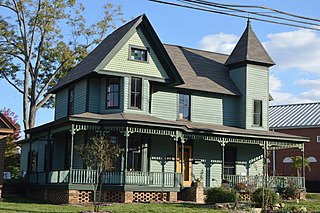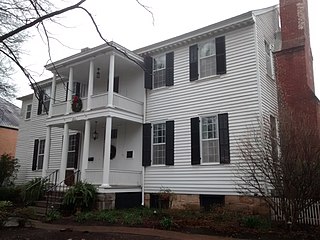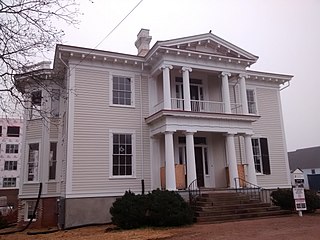
The Joel Lane House, also known as Wakefield, was built in 1769 and is now a restored historic home and museum in Raleigh, North Carolina. It is the oldest dwelling in Wake County and contains collections of 18th century artifacts and period furnishings. The museum grounds include a detached middle-class home built circa 1790, a formal city garden, and a period herb garden. The house is named after Joel Lane, the "Father of Raleigh" and "Father of Wake County."

Falls, is an unincorporated community in Wake County, North Carolina, United States, situated on Old Falls of Neuse Road, between Raleigh and Wake Forest, near the Wakefield Plantation development. Falls Dam, on the Neuse River, is within the community.

The Willis M. Graves House, also known as the Graves-Fields House and Oakcrest, is a historic home located on Oberlin Road in Raleigh, Wake County, North Carolina. It was built about 1884 in the freedmen's village of Oberlin, and is a two-story, frame Queen Anne style dwelling. It has a projecting, two-story polygonal bay capped by a very large gable; one-story wraparound porch; and a projecting, two-story square tower with a pyramidal roof. It was built by Willis M. Graves, an African-American brick mason.
The Harmony Plantation, also known as Montague-Jones Farm, is a historic plantation house located at 5104 Riley Hill Road near Wendell, North Carolina, a town in eastern Wake County. It was built in 1833, and is a two-story, three bay, single-pile, Greek Revival style frame dwelling. It is sheathed in weatherboard, has a hipped roof, and a gabled rear ell. The front facade features a centered, double-tier pedimented, front-gabled portico with bracketed cornice and unfluted Doric order columns. Also on the property is a contributing one-story, rectangular, beaded weatherboard building that once housed a doctor's office (1833).
The Green-Hartsfield House, also known as the Hartsfield House, is a historic home located near Rolesville, Wake County, North Carolina, a satellite town northeast of the state capital Raleigh. Built in 1805, the house is an example of Late Georgian / Early Federal style architecture. It is a two-story, three bay, single pile, frame dwelling sheathed in weatherboard, with a two-story gable-roofed rear ell. A one-story rear shed addition was added in the 1940s. The house was restored between 1985 and 1987. Also on the property is a contributing frame barn.

Utley-Council House is a historic home located near Apex, Wake County, North Carolina. It was built about 1820, and is an asymmetrical, two-story, three bay, frame Federal period dwelling. It has a hall-and-parlor plan. Also on the property is a contributing mortise-and-tenon smokehouse.
Wilkinson-Dozier House is a historic plantation house located near Conetoe, Edgecombe County, North Carolina. It was built about 1815, and is a two-story, three bay by two bay, Federal style frame dwelling. The front facade features a tall, rather delicate double portico with a Chinese Chippendale balustrade.
Middleton House, also known as the Chatham–Hanes House and R. Philip Hanes Jr. House, is a historic home located at Winston-Salem, Forsyth County, North Carolina. It was built about 1829, and located on a hill overlooking the Savannah River in northwestern South Carolina. The two-story, five bay, Federal style frame dwelling was dismantled and moved to its present site in 1930. It was subsequently reconstructed by architect William Roy Wallace and set in a landscape designed by Ellen Biddle Shipman. The front facade features a two-tier, center-bay porch with graceful Tuscan order columns. Also on the property is the contributing compatible garage/apartment. After Phillip Hanes’ death in 2011 the house and grounds were donated to Wake Forest University but the house was vacant. In 2020 the house and surrounding land was sold to a developer and the house was purchased and renovated into a family home again.
Gardner House is a historic home located near Jamestown, Guilford County, North Carolina. It was built in 1827, and is a two-story, four bay by two bay, brick dwelling. It has a one-story, four bay rear wing and features an unusual arch-linked double chimney. The interior has a modified Quaker plan. Also on the property is the site of the Gardner gold mine.
Matthews Place, also known as Ivey Hill, is a historic plantation house located near Hollister, Halifax County, North Carolina. It consists of two houses: a two-story, three bay, Georgian-style frame dwelling dated to about 1800, attached to a two-story, three bay, Greek Revival-style frame dwelling added about 1847. The houses are set a right angles to the other. The older house has a single-shoulder brick chimney. The Greek Revival house features a pedimented front entrance porch with simple fluted Doric order columns.

Waverly Plantation is a historic plantation house located near Cunningham, Person County, North Carolina. It was built about 1830, and is a Late Federal style frame dwelling consisting of a two-story, three bay by two bay main section, with an attached 1 1/2-story, one bay by two bay section. Both sections rest on brick foundations, are sheathed in weatherboard, and have gable roofs.

Green River Plantation is a historic plantation house on over 360 acres located near Columbus, Polk County, North Carolina. The oldest section of the "Big House" was built between the years 1804–1807, and is a two-story, four bay, Late Federal style frame dwelling. A later two-story, four bay, brick Greek Revival style dwelling was built beside the original structure in the mid-19th century. The two sections were joined in the late 19th century by a two-story section and grand staircase to form a structure that is over 10,000 square feet in size and boasts over 42 rooms and spaces. The plantation house was built by Joseph McDowell Carson, son of Col. John Carson, who built Carson House at Marion, North Carolina. The later-built section of the home was the residence of Samuel Price Carson, North Carolina State Senator and U.S. Federal Representative, and younger brother of Joseph McDowell Carson.
William A. Curtis House, also known as Villa Florenza, is a historic home located at Raleigh, Wake County, North Carolina. It was built about 1915, and is a two-story, three bay wide, Late Victorian-style frame dwelling with a pyramidal roof. It has a full-height pedimented wing and one-story rear kitchen ell. It features a one-story wraparound porch. It was home to a prominent African-American family.

Haywood Hall, also known as the Treasurer John Haywood House, is a historic home located at Raleigh, Wake County, North Carolina. It was built in 1792, and is a two-story, five bay, Federal-style frame dwelling with a central hall plan. It features a two-story front porch with attenuated fluted Doric order columns. It was the home of North Carolina State Treasurer John Haywood (1754-1827). It is now open as a historic house museum.

Lewis-Smith House is a historic home located at Raleigh, Wake County, North Carolina, USA It was built between 1854 and 1856, and is a two-story, three bay, Greek Revival-style frame dwelling with a low hipped roof and Italianate-style brackets. It features a two-tier pedimented entrance portico, with paired Doric order columns at the first level and well-detailed Ionic order ones at the second. Two-story, demi-octagonal projecting bays were added to the sides in the early-20th century.

Rogers-Bagley-Daniels-Pegues House is a historic home located at Raleigh, Wake County, North Carolina. It was built about 1855, and is a two-story, three bay by two bay, Greek Revival-style frame dwelling with a low hipped roof and Italianate-style accents. It has a hip roofed porch with Doric order posts and bay windows. It was built by Sion Hart Rogers (1825-1874), a Congressman from and Attorney General of North Carolina. It was the home of Josephus Daniels (1862-1948) from about 1894 to 1913.

White-Holman House is a historic home located at Raleigh, Wake County, North Carolina. It was built about 1798, and is a two-story, three bay, frame dwelling with a two-story wing and one-story rear shed addition. It is sheathed in weatherboard and has a side-hall plan. It was built by William White (1762–1811), North Carolina Secretary of State, 1798–1811. The house was moved to its present location in April 1986.
Thompson House, also known as the William Thompson House, is a historic plantation house located near Wake Forest, Wake County, North Carolina. It was built about 1853, and is a two-story, three-bay Greek Revival-style frame dwelling. It is sheathed in weatherboard, sits on a fieldstone foundation, and has four brick chimneys, two on each side. Also on the property is a contributing 1+1⁄2-story barn. The house and barn were moved to its present location in 2004.
Powell House is a historic plantation home located near Wake Forest, Wake County, North Carolina, USA. It was built about 1800, and is a large two-story, five bay, Federal-style frame dwelling. The house has two one-story rear additions and exterior end chimneys. The front facade features a full height portico added about 1940.
Vernon, also known as the Anna Maria Ward House, was a historic plantation house located near Mount Olive, Wayne County, North Carolina. It was built about 1837, and was a two-story, five bay by two bay, Federal style frame dwelling. It sat on a brick pier foundation and one-story shed porch that replaced a mid-19th century two-story porch of Italianate design. It has been demolished.













